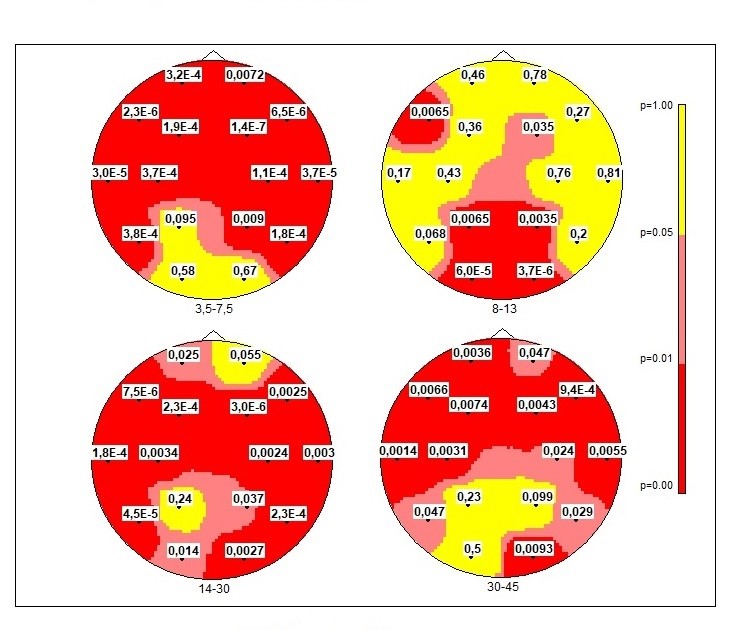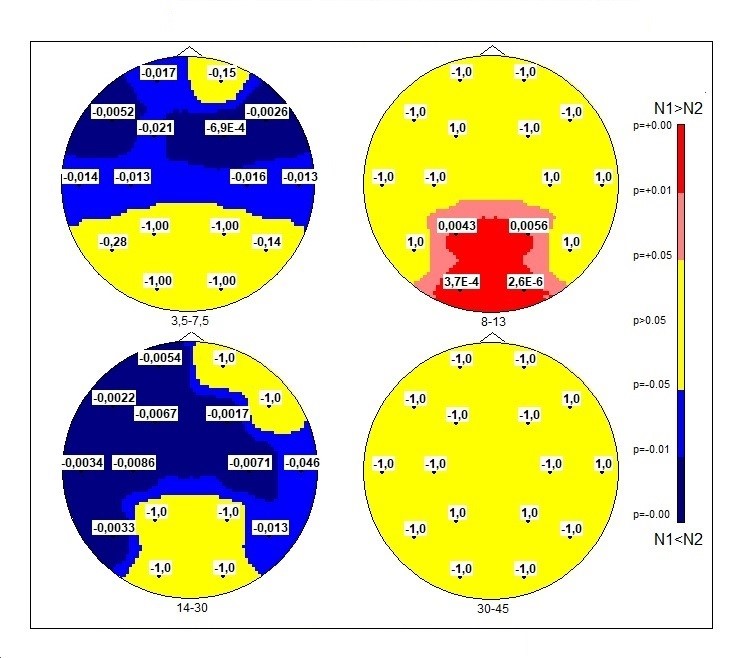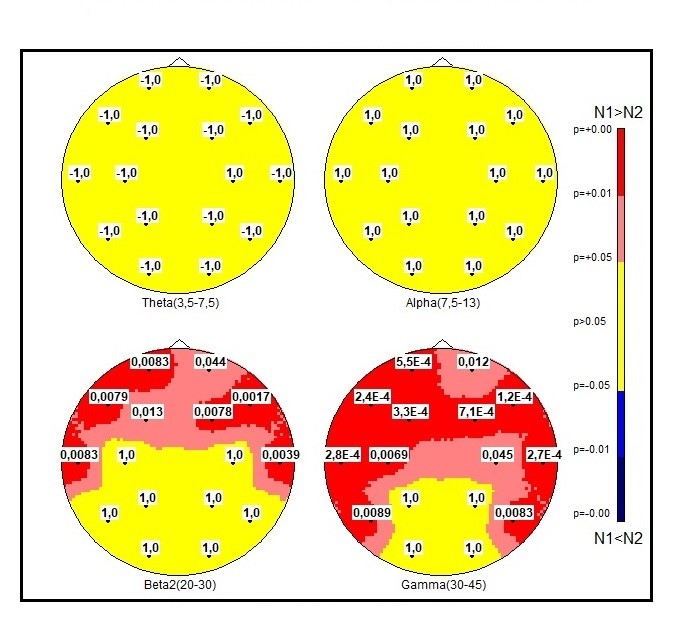Journal of Modern Foreign Psychology
2024. Vol. 13, no. 2, 71–83
doi:10.17759/jmfp.2024130207
ISSN: 2304-4977 (online)
Differences in EEG Spectral Power and Behavioral Profiles between Children with Non-syndromic Autism Spectrum Disorder and Down Syndrome with Comorbid Autistic Features
Abstract
The diverse nature of the autistic spectrum disorders group (ASD) may be associated with EEG patterns, which may be specific for different profiles of ASD. Approximately 15% of children with Down syndrome (DS) exhibit autistic features, and the cognitive impairment associated with this syndrome remains unclear. We aimed to explore the potential similarities in behavioral disorders and their EEG correlates between non-syndromic ASD and DS children with comorbid autistic features. Three groups of right-handed boys participated in the experiments: typically developed boys (“control”) — N = 36; mean age = 7.11, SD = 0.86; DS group age N = 15, mean age 7.2 (SD = 0.94), and ASD group; N — 36; mean age — 7.11, SD — 0.86; DS group age N — 15, mean age 7.2 (SD — 0.94), and ASD group; N — 39; mean age — 6.24 (SD — 0.91). Increased theta rhythm spectral power in EEG was found in the frontal and temporal areas, while the alpha rhythm in the occipital area exhibited a reduction in children with DS and ASD as compared with control. The alterations in bioelectric activity, such as increased spectral power f theta in the frontal area and a reduction of EEG spectral power in the occipital alpha band, were partially similar in children with DS and with ASD, albeit less pronounced in DS. A distinctive EEG characteristic of DS was the heightened spectral power of beta rhythm compared to the control group. The Psychoeducational Profile testing in DS revealed inferior results in verbal development (p < 0.05) and cognitive representations (p < 0.05) compared to both the control and ASD groups. However, no differences were found in the total cognitive development scale between DS and ASD. At the behavioral level, impaired verbal and non-verbal intelligence was more prominent in DS than in ASD.
General Information
Keywords: Down syndrome, autistic spectrum disorders, EEG, cognitive development
Journal rubric: Psychology of Special and Inclusive Education
Article type: scientific article
DOI: https://doi.org/10.17759/jmfp.2024130207
Funding. This study was partially supported by the RFBR grant (No 20-013-00395А) and funds within the state assignment of the Ministry of Education and Science of the Russian Federation for 2019—2023.
Received: 10.05.2024
Accepted:
For citation: Luschekina E.A., Martynova O.V., Strelets V.B. Differences in EEG Spectral Power and Behavioral Profiles between Children with Non-syndromic Autism Spectrum Disorder and Down Syndrome with Comorbid Autistic Features [Elektronnyi resurs]. Sovremennaia zarubezhnaia psikhologiia = Journal of Modern Foreign Psychology, 2024. Vol. 13, no. 2, pp. 71–83. DOI: 10.17759/jmfp.2024130207.
Full text
In English
Introduction
Methods
Results
|
Bands\Electrodes |
FFp1 |
FFp2 |
FF7 |
FF8 |
FF3 |
FF4 |
TC3 |
CC4 |
|
3.5-7.5Hz |
90.58 |
50.47 |
17.19 |
15.49 |
10.30 |
22.26 |
13.06 |
12.73 |
|
8-13Hz |
00.00 |
00.00 |
50.60 |
00.00 |
00.00 |
30.60 |
00.00 |
00.00 |
|
14-30Hz |
30.98 |
00.00 |
15.24 |
60.83 |
10.03 |
16.77 |
10.34 |
60.58 |
|
30-45Hz |
60.33 |
30.26 |
50.59 |
80.08 |
50.44 |
60.12 |
70.53 |
50.81 |
|
Bands\Electrodes |
CT3 |
CT4 |
TT5 |
TT6 |
PP3 |
PP4 |
OO1 |
OO2 |
|
3.5-7.5Hz |
90.34 |
11.13 |
90.33 |
10.40 |
00.00 |
50.20 |
00.00 |
00.00 |
|
8-13Hz |
00.00 |
00.00 |
00.00 |
00.00 |
50.59 |
60.38 |
11.99 |
16.42 |
|
14-30Hz |
60.43 |
60.84 |
12.41 |
10.01 |
00.00 |
30.55 |
40.67 |
60.69 |
|
30-45Hz |
60.54 |
40.02 |
30.26 |
30.82 |
00.00 |
00.00 |
00.00 |
50.16 |
Conclusion
References
- Gorbachevskaya N.L., Mamokhina U.A., Vershinina H.V., Pereverzeva D.S., Kobzova M.P., Mitrofanov A.A., Sorokin A.B. Osobennosti spektral'nykh kharakteristik EEG u lits s rasstroistvami autisticheskogo spektra [Specificities of EEG spectral characteristics in individuals with autism spectrum disorders] [Electronic resource]. Psikhiatriya = Psikhiatriya, 2018. Vol. 78, pp. 48—54. URL: https://www.journalpsychiatry.com/jour/article/view/335 (Accessed 28.06.2024). (In Russ.).
- Sysoeva O.V. Neirofiziologicheskie markery kak svyazuyushchee zveno mezhdu genami i povedeniem: primery iz redkikh geneticheskikh sindromov, assotsiirovannykh s rasstroistvom autisticheskogo spektra [Neurophysiological markers that link genes and behavior in humans: examples from rare genetic syndromes associated with autism spectrum disorders]. Geny i Kletki = Genes and cells, 2023. Vol. 18, no. 4, pp. 297—307. DOI:10.23868/gc567774
- Anderson J.S., Nielsen J.A., Ferguson M.A., Burback M.C., Cox E.T., Dai L., Gerig Guido, Edgin J.O., Korenberg J.R. Abnormal brain synchrony in Down syndrome. Neuroimage: Clinical, 2013. Vol. 24, no. 2, pp. 703—715. DOI:10.1016/j.nicl.2013.05.006
- Bernad‐Ripoll S., O'Neill M., Capone G.T. Children with Down syndrome who experience developmental skill loss, characterization, and phenomenology: A case series. American Journal of Medical Genetics, 2023. Vol. 193, no. 4, article ID e32077. 14 p. DOI:10.1002/ajmg.c.32077
- Bosl W.J., Tager—Flusberg H., Nelson C.A. EEG Analytics for Early Detection of Autism Spectrum Disorder: A data-driven approach. Scientific Reports, 2018. Vol. 1, no. 8, article ID 6828. 20 p. DOI:10.1038/s41598-018-24318-x
- Bray M. Exploring fluency in Down Syndrome. A discussion of speech dysfluencies for professionals and parents. Albury: J&R Press Ltd, 2016. 245 p.
- Chan K.L.R., Ouyang G. Impact of child-centered play therapy intervention on children with autism reflected by brain EEG activity: A randomized controlled trial. Research in Autism Spectrum Disorders, 2024. Vol. 112, article ID 102336. 18 p. DOI:10.1016/j.rasd.2024.102336
- Presson A.P., Partyka G., Jensen K.M., Devine O.J., Rasmussen S.A., McCabe L.L. Current estimate of Down syndrome population prevalence in the United States. The Journal of Pediatrics, 2013. Vol. 163, no. 4, pp. 1163—1168. OI:10.1016/j.jpeds.2013.06.013
- Moreno J., Morales Matamoros O.M., Aguilar del Villar E.Y., Espinosa Q.H., Hernández C.L. Deep Convolutional Neural Networks for Facial Emotion Detection in Children with Down Syndrome during Dolphin-Assisted Therapy. Healthcare, 2023. Vol. 11, no. 16, article ID 2295. 21 p. DOI:10.3390/healthcare11162295
- Bonne S., Iftimovici A., Mircher C., Conte M., Louveau C., Legrand A., Chaumett B. Down syndrome regression disorder, a case series: Clinical characterization and therapeutic approaches. Frontiers in Neuroscience, 2023. Vol. 17, article ID 1126973. 7 p. DOI:10.3389/fnins.2023.1126973
- Duffy F., Als H. Autism, spectrum or clusters? An EEG coherence study. BMC Neurology, 2019. Vol. 19, no. 27, 13 p. DOI:10.1186/s12883-019-1254-1
- Garakh Z., Zaytseva Y., Kapranova A., Fiala O., Horacek J., Shmukler A., Gurovich I.Ya., Strelets V. EEG correlates of a mental arithmetic task in patients with first episode schizophrenia and schizoaffective disorder. Clinical Neurophysiology, 2015. Vol. 126, no. 11, pp. 2090—2098. DOI:10.1016/j.clinph.2014.12.031
- Kurkin S., Smirnov N., Pitsik E., Kabir M.S., Martynova O., Sysoeva O., Portnova G., Hramov A. Features of the resting-state functional brain network of children with autism spectrum disorder: EEG source-level analysis. The European Physical Journal Special Topics, 2023. Vol. 232, no. 35, pp. 683—693. DOI:10.1140/epjs/s11734-022-00717-0
- Yerys B.E., Tunç B., Satterthwaite T.D., Antezana L., Mosner M.G., Bertollo J.R., Guy L., Schultz R.T., Herrington J.D. Functional Connectivity of Frontoparietal and Salience/Ventral Attention Networks Have Independent Associations With Co-occurring Attention-Deficit/Hyperactivity Disorder Symptoms in Children With Autism. Biological Psychiatry: Cognitive Neuroscience and Neuroimaging, 2019. Vol. 4, no. 4, pp. 343—351. DOI:10.1016/j.bpsc.2018.12.012
- Li J., Kong X., Sun L., Chen X., Ouyang G., Li X., Chen S. Identification of autism spectrum disorder based on electroencephalography: A systematic review. Computers in Biology and Medicine, 2024. Vol. 170, article ID 108075. DOI:10.1016/j.compbiomed.2024.108075
- Luschekina E.A., Luschekin V.S., Strelets V.B. EEG coherence study in children with autistic spectrum disorders: heterogeneity of the group. Human Physiology, 2021. Vol. 47, no. 2, pp. 137—146. DOI:10.1134/S0362119721020067
- Luschekina E.A., Luschekin V.S., StreletsV.B. EEG Spectral Power in Children with Autistic Spectrum Disorders: Heterogeneity of the Group. Human Physiology, 2019. Vol. 45, no. 3, pp. 242—248. DOI:10.1134/S036211971902004X
- Portnova V.G., Nekrashevich V.M., Morozova V.M., Martynova V.O., Sharaev G.M. New approaches to clinical electroencephalography analysis in typically developing children and children with autism. Cognitive Systems Research, 2023. Vol. 78, pp. 23—32. DOI:10.1016/j.cogsys.2022.11.003
- Bostelmann M., Ruggeri P., Circelli A.R., Costanzo F., Menghini D., Vicari S., Lavenex P., Lavenex P.D. Path Integration and Cognitive Mapping Capacities in Down and Williams Syndromes. Frontiers in Psychology, 2020. Vol. 11, no. 57, article ID 571394. 22 p. DOI:10.3389/fpsyg.2020.571394
- Meneghetti C., Toffalini E., Lanfranchi S., Carretti B. Path Learning in Individuals With Down Syndrome: The Floor Matrix Task and the Role of Individual Visuo-Spatial Measures. Frontiers in Human Neuroscience, 2020. Vol. 14, article ID 107. 14 p. DOI:10.3389/fnhum.2020.00107
- Channell M.M., Phillips B.A., Loveall S.J., Conners F.A., Bussanich P.M., Klinger L.G. Patterns of autism spectrum symptomatology in individuals with Down syndrome without comorbid autism spectrum disorder. Journal of Neurodevelopmental Disorders, 2015. Vol. 7, no. 5, pp. 1—9. DOI:10.1186/1866-1955-7-5
- Hamner T., Manisha D., Udhnani M.D., Osipowicz K.Z., Lee N.R. Pediatric Brain Development in Down Syndrome: A Field in Its Infancy. Journal of the International Neuropsychological Society, 2018. Vol. 24, no. 9, pp. 966—976. DOI:10.1017/S1355617718000206
- Schopler E., Lansing M.D., Reichler R.J., Marcus L.M. PEP-3. Psychoeducational profile [Electronic resource]. (3rd ed.). 2005 // WPS: Unlocking potential. URL: https://www.wpspublish.com/pep-3-psychoeducational-profile-third-edition (Accessed 20.05.2024).
- Duville M.M., Corona-González C.E., De León R.R., Vera A.R., Flores-Jimenez M.S., Ibarra-Zarate D.I., Alonso-Valerdi L.M. Perception of task-irrelevant affective prosody by typically developed and diagnosed children with Autism Spectrum Disorder under attentional loads: electroencephalographic and behavioural data. Data in Brief, 2023. Vol. 48, article ID 109057. 16 p. DOI:10.1016/j.dib.2023.109057
- Portnova G., Martynova O. Macro-and microstates of resting-state EEG in children with low-functioning autism. Advances in Neurodevelopmental Disorders, 2023. 15 p. Preprint. DOI:10.1007/s41252-023-00374-x
- Juarez-Martinez E.L., Sprengers J.J., Cristian G., Oranje B., van Andel D.M., Avramiea A.E., Bruining H. Prediction of behavioral improvement through resting-state electroencephalography and clinical severity in a randomized controlled trial testing bumetanide in autism spectrum disorder. Biological Psychiatry: Cognitive Neuroscience and Neuroimaging, 2023. Vol. 8, no. 3, pp. 251—261. DOI:10.1016/j.bpsc.2021.08.009
- Balathay D., Narasimhan U., Belo D., Anandan K. Quantitative assessment of cognitive profile and brain asymmetry in the characterization of autism spectrum in children: A task-based EEG study. Proceedings of the Institution of Mechanical Engineers, Part H: Journal of Engineering in Medicine, 2023. Vol. 237, no. 5, pp. 653—665. DOI:10.1177/09544119231170683
- Reinhold J.A., Molloy C.A., Manning-Courtney P. Electroencephalogram abnormalities in children with autism spectrum disorders. Journal of Neuroscience Nursing, 2005. Vol. 37(3), pp. 136—138. DOI:10.1097/01376517-200506000-00003
- Neo W.S., Foti D., Keehn B., Kelleher B. Resting-state EEG power differences in autism spectrum disorder: a systematic review and meta-analysis. Transl Psychiatry, 2023. Vol. 13, article ID 389. 14 p. DOI:10.1038/s41398-023-02681-2
- Ribeiro L.B., da Silva Filho M. Systematic Review on EEG Analysis to Diagnose and Treat Autism by Evaluating Functional Connectivity and Spectral Power. Neuropsychiatric Disease and Treatment, 2023. Vol. 19, pp. 415—424. DOI:10.2147/NDT.S394363
- Ruiz-Mejias M. Outer Brain Oscillations in Down Syndrome. Frontiers in Systems Neuroscience, 2019. Vol. 13, article ID 17. 8 p. DOI:10.3389/fnsys.2019.00017
- Schopler E., Lansing M. Psychoeducational Profile: Support of autistic and delayed children. Minsk, 1997. 200 p.
- Simashkova N.V. Psychotic forms of atypical autism in children [Electronic resource]. Zhurnal nevrologii i psikhiatrii im. S.S. Korsakova, 2006. Vol. 106, no. 10, pp. 17—26. URL: https://pubmed.ncbi.nlm.nih.gov/17117670/ (Accessed 20.05.2024).
- Nunnally A.D., Nguyen V., Anglo C., Sterling A., Edgin J., Sherman S., Berry-Kravis E., del Hoyo Soriano L., Abbeduto L., Thurman A.J. Symptoms of autism spectrum disorder in individuals with Down syndrome. Brain Sciences, 2021. Vol. 11, no. 10, article ID 1278. 16 p. DOI:10.3390/brainsci11101278
- Clark C.A.C., Fernandez F., Sakhon S., Spano G., Edgin J.O. The medial temporal memory system in Down syndrome: Translating animal models of hippocampal compromise. Hippocampus, 2017. Vol. 27, no. 6, pp. 683—691. DOI:10.1002/hipo.22724
Information About the Authors
Metrics
Web Views
Whole time: 239
Previous month: 36
Current month: 16
PDF Downloads
Whole time: 68
Previous month: 5
Current month: 2
Total
Whole time: 307
Previous month: 41
Current month: 18



